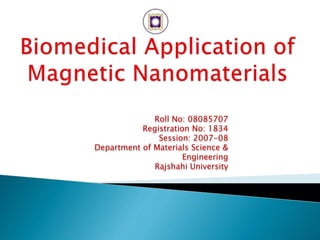This document discusses a project to characterize magnetic nanoparticles for use in biomedical applications. The objectives are to:
1. Characterize the magnetic nanoparticles and study their AC susceptibility, size distribution, magnetic properties, and relaxation to determine parameters like magnetic moment and blocking temperature.
2. Develop a system to detect biological targets using magnetic nanoparticles and improve the system's sensitivity.
3. Validate the magnetic immunoassay technique by comparing results to conventional methods and analyzing outcomes for biological targets.



























